Text
15 minutes alone with a cold cup of tea. Window is open.
1. If i'm not me, then who is?
2. If I'm not me, then who am I?
3. If you're not you, then who is you, and where are they? And do they also have your driving licence?
4. If I'm not me, then where is the person that is, and what have they been doing all this time? I mean, honestly, it's a lot of time to have been me, and I haven't read or heard about them? How on earth have they been using all this time!
5. How on earth! Or not at all on earth. But then if not on earth, then where?
6. In, out, in out, shake it all about.
7. Yesterday we had chips with dinner. We had salad with the chips – really super-fresh salad, very crunchy. Nice dressing. I think I could really eat chips with salad for every meal. No need for anything else. Hot chips with fresh salad.
8. When things grow in the garden they suck up nutrients from the soil, and create food from the light of the sun. When the soil is depleted of nutrients, how is it feeling? Worn out, tired, maybe low energy. If I was soil I would think of a vegetable as a kind of parasite. Not only is it getting energy from the sun, but it also needs my nutrients! How demanding!
9. When you eat a vegetable that has been grown under natural light, in a way you're eating the sun.
10. Some vegetables are grown under electric lights inside shipping containers. When you eat those vegetables, in a way you're eating electricity? Take that back a few steps further and you're eating the wind, or the sun, or coal. But then isn't that the same for everything.
11. I poured a bag of mouldy leaves onto my garden. There was a lot of water in the bag too. It didn't smell great, but there were a lot of worms in the bag which made me feel quite good about it. Being in a black bag with a bit of water and some mouldy leaves must be like a luxury holiday for worms.
12. A worm on a plane on the way to the Bahamas. His suitcase is checked in and he's listening to a podcast on the in-flight entertainment system.
13. A plane for worms is much smaller than a plane for humans because you can fit more in.
14. A plane for worms doesn't need jet fuel, it runs on worm-excrement, AKA worm casings.
15. Worms don't pack their luggage in worm casings, they do actually use regular suitcases like all other species on planet earth.
16. When bears hibernate in caves for the winter, they have to put their belongings in big yellow storage like every other species on planet earth.
17. Have you ever been to a big yellow storage? They have all these anonymous rooms that have lots of property stored inside. What I found fascinating is that they don't have separate areas for all the different customer species. All the ants’ storage rooms are mixed in with the buffalo ones, and the bacteria etc. And all the storage rooms are the same size too. I always wondered why a bacteria would need a room as big as the human ones – have they really got that much stuff? And where are they moving house to?
18. A tin that used to hold football cards but now just holds air and bacteria. I'm thinking of painting it yellow.
19. Every surface has a film of bacteria on it – in reality am I touching anything anything apart from bacteria? I'm just a bacteria-toucher?
20. Twenty is plenty.
21. But 21 is much better.
22. A mouse that's actually a mouse. You plug its tail into your computer and can use it straight away – it's plug and play.
23. A keyboard that's actually a real mouse. Each rib is assigned a character or function key. Takes a while to type things out.
24. A monitor that is actually a mouse. All its hairs align in different configurations to make images appear. Lots of people have multiple monitors because mice are just so small and it's hard to see anything at all if you just have one mouse.
25. About 25 years ago, a pager that was actually a mouse. But it wasn't a visual display that you would look at. Instead, these mice had learned to talk, in a way. So when a message came through they'd run out of your pocket, up your shoulder and speak it into your ear. These guys weren't popular for long. It turned out that they absolutely loved playing tricks on their owners and so would just make up messages – "your house is on fire", or "I just saw your spouse in the front of your car with another man."
26. We're 2.8 billion miles from the sun. But it doesn't seem that far away.
0 notes
Text
15 minutes in a different country with notifications on, and music playing. Post-toast.
1. A timer that doesn't let you know when the time has run out. This is on purpose. It's a conditioning tool to get used to disappointment and un-delivered returns.
2. The post office down the road has a meat counter. It's new, but it seems to be well stocked and well used. I like how the postmaster counts out the sausages.
3. A swimming pool filled with coca-cola and excited children.
4. A swimming pool filled with coca-cola and excited school children on the news due to a large-scale wasp infestation.
5. A slick desktop that captures sweat in small gulleys and directs it to a sweat-trap, a bit like a drip tray at the bar in the pub, but better smelling.
6. In the park there's a large patch of greass that's often covered in a couple of inches of leaves. Even when it's not autumn. I know it's a patch of grass under there because I once took a look below the layers of leaf-mould. Bright green, freshly mown grass.
7. Sometimes when playing football, my largest toe becomes very stiff and pointy. It seems to grow by a couple of centimeteres. If I kick the ball with my largest, stiff, pointy toe, the ball immediatley shoots into the stratosphere, around the world once or twice, and lands in the sea.
8. Flagpoles without any flags on them. Are they just poles now?
9. A pole at each of the poles. They're connected to each other in the middle.
10. Some lightbulbs have a gas inside them that helps to create the light when electricity passes through it. There's a factory process somewhere responsible for making sure that there is gas inside each of these lightbulbs. If every lightbulb were to break at once, all the gas would end up in the atmosphere.
11. A map of the world without any land mass on it. Only ocean. Everywhere.
12. A map of the world with only land on it. No ocean. Nowhere.
13. A map with nothing on it yet – it's a map of uncharted territories, ones that we haven't gotten around to yet. It's not a piece of blank paper, no. It's a map-in-waiting.
14. Areas of the planet that are waiting patiently to be discovered. Somehow overlooked and unseen so far, just waiting for their moment in the limelight. A name, some co-ordinates to call their own.
15. There's a tree on the hill that somehow never seems to drop its leaves. It's not an ever-green – the leaves change colour with the seasons, they just don't ever fall off. One day I take a hike up to the tree to try to figure out its secret. When I get up close, I realise that they're not leaves on the tree, but thousands and thousands of plastic bags. This is only part of the secret, so I build a camp and hang out there for a season or two to see what's happening with the colour changes. One early-autumn night, I wake up to take a leak. Tweaking my eyes to the light, rustling up in one of the branches I see a tiny tiny old man, slowly untying some of the green bags, and replacing them with orange Sainsbury's bags.
16. Later on I might walk down to the village to get a haircut. If I'd told my dad this scintillating piece of information, he'd have replied 'which one?'
17. Over the past few years my strides have been getting shorter. My legs are the same length, my feet are the same size. But for whatever reason it takes me more strides to go the same distance. Maybe the earth is getting longer?
18. Cracking an egg for breakfast is such an incredibly satisfying feeling, that sometimes I'll crack five or six eggs just for the pure hell of it. That's living.
19. Pixels are everywhere. Right in front of your eyes. Behind your head. Behind other pixels. The entire environment is just made of pixels.
20. Pixels that can be detached from screens and rearranged into different forms.
21. Pixels that don't change colours, but instead are set to one colour for their entire lives.
22. Enormous, giant pixels living in the woods behind your house. A small community of exiled pixels, cooking food on a campfire together, occasionally venturing into your garden to steal your laundry.
23. You catch one of the pixels one day. It feels good to get hold of the villain, but after a while you just feel sad. You don't know what to do with the pixel, so you just let it go, sending it off with a packet of sandwiches wrapped in brown paper.
1 note
·
View note
Text
15 minutes sat on the floor, my bum going numb
1. Insect repellent that I invented called 'Mosquito Massacre'. It's not a roll-on or anything, but a battery you need to wire up to your skin. It electrocutes mosquitoes as they take a bite. I guess it's less of a repellent and more about revenge than anything else.
2. Floor tiles that have a bit of give in them, so that when I sit on them, they don't make my butt go numb.
3. A cream you can put onto your numb parts to bring the feeling back. So many creams are about removing sensitivity – making things numb – how about something that makes it hypersensitive
4. A beer that you drink that doesn't make all the demons go away, but that brings them into your mind at 10x intensity.
5. Some batteries don't seem to last very long. Others last a very long time indeed.
6. At home a few weeks ago I picked up the TV remote and it wasn't working. I opened the back cover to replace the batteries and they'd gone all leaky. But it wasn't a fluid. It was a powder. It was like pollen. For a few moments I was quite confused.
7. Carpets that don't harbour dust mights. Instead they're home to snakes.
8. A ringtone that's pleasant.
9. A phonecall that's not like getting a parking ticket.
10. A parking certificate that rewards your fantastic parking.
11. A glass made out of plastic but you can't tell that it's plastic. It feels exactly like glass. Including when you smash it and try to pick up the pieces.
12. My child is so incredibly hungry all the time. She will eat all the food. All the vegetables. Then the cutlery and the chopsticks. Then the plate and the bowl and the cup. After that she starts on the table, the chairs. Then the floor and walls and down the street. I haven't seen her for quite a long time, but then I haven't seen anything. There's nothing left.
13. In the garden there's a plant growing that looks a bit like a tomato plant. But it's not. It doesn't smell like one either. It's definitely not a tomato plant.
14. Blinds.
15. Blinds that cover your window but that don't block out the light.
16. Blinds that block the light, but still allow outsiders to know what's going on inside the room by translating all the action into a commentary and broadcasting it to the outside world.
17. In the village there's a shop. It's empty apart from one huge LCD TV on one wall, the sort you get in football pubs, and a tiny camera in one corner. When you go into the shop you can see yourself on the TV, and in the corner two small talking heads appear. They commentate your actions back to you, but as if you're not there. There's nothing to buy in this shop, but you still get charged on your way out.
18. Colours all mixed together.
19. Colours don't stick to surfaces, they're not sticky anymore. They just flake off and onto the floor like dust, and all swirl together. Everything is invisible apart from a swirl of brown dust. If you pick up some of the dust and look carefully, gently, you see a rainbow.
20. Furniture that's designed by children with an overestimation of adult forms. Chairs are low, but seats are enormous. My dads pants always used to look gigantic to me.
21. Yellow fruits on a tree. You don't know what they are, but they taste good. You pick one and enter it into the local village show. But you don't know what to write onto the label, or which category to enter it into. You call it BOB fruit. No-one else has ever seen one of these before either. It takes second place in the stonefruit category. Later on in the day you go back to find the tree it was growing on, but it's not there anymore. Instead there's a pub. So you go in and have a pint.
22. Your head is a swirling mess made worse by sunken eyes and a whooshing feeling when you move your head. The sound of lightsabres accompanies the whooshing. It's kind-of fun.
23. Sweating, through the night. You wake up in a puddle and your bed has dissolved. You're back on the floor tiles.
24. Fingertips that don’t leave fingerprints.
25. Gloves that only fit your hands.
26. Hands that only fit your gloves, but they're not your hands, you have to try and find them.
27. You find the hands that fit your gloves. They belong to a 15th century Belgian monarch. You found out their hands fit your gloves from analysing a painting in the National Gallery, carefully measuring the width and length of the fingers, then the head and body size to get an accurate idea of the size of their hands.
28. You get rid of your gloves at a charity shop because they're not really of any use for you. The next week you walk past a guy wearing them in the village.
0 notes
Text
15 minutes sat at a granite table. There are orange peels drying on the window bars. It's quiet.
1. A feeling you get when you're under the weather. It's purely visual, but you feel it instead of seeing it.
2. Rain that comes down at precisely 30mph. There's a guy hiding in the trees with a speed-gun. If any rain travels faster than that they get a sin-bin, and banned from raining for 2 weeks.
3. A racetrack made out of corrugated cardboard that kids have painted and drawn on. The racing drivers have to somehow make out which part is the track, and which parts are the kids trying to lead them off course.
4. A book written by a koala head-butting a mobile phone keyboard.
5. Pages of a book made out of a very fibrous material that crumbles when the pages are turned.
6. More sand. It's everywhere.
7. A kitchen timer with oil instead of sand. Over time, a long long time, the oil does eventually turn to sand.
8. An egg that doesn't boil in 3 minutes, it's been modified to take just 3 seconds.
9. A computer keyboard covered in soy beans. Each morning when you sit down to work you have to clean them off, and get in between the keys with a toothpick. It takes quite a long time but you get it done, and eventually it becomes like a ritual, getting you started for the day. But then overnight, somehow they grow back again. Grow? Or just appear. It's funny, because until you open your laptop each morning there's absolutely no clue that they would be there. Before this started happening, you'd never actually seen a soybean.
10. Walking through the bus interchange late at night. There's a lot of people still about, which is strange, as it's Monday.
11. A water bottle that's empty. The lid no longer fits properly.
12. A water bottle made from mycelium. Leave it too long and it's an oyster mushroom
13. A bin that empties itself.
14. A bin that empties itself and all other bins nearby.
15. A bin that went missing when it was emptying itself. The neighbourhood watch team put up posters in the village, but there was no response. The local whatsapp groups had been pinging all week with suspected sightings, and a few other tip-offs. Sadly, the bin was never found.
16. A bin with no openings in which to put rubbish.
17. A bin with one of those openings that you have to pull with a handle. It stops seagulls getting the litter, but also stops you from putting your litter inside it.
18. 3 weeks ago you were on the phone, but you weren't really listening to what the caller was saying. This morning, at around 10am, a FedEx driver knocks on your door with a delivery. It's 15 washer-dryers. You're not sure where to put them. This is your job now.
19. In the greenhouse on a rainy Monday afternoon. It smells musty, but a good, fresh must. The kind of must that would make a great aftershave.
20. You like wearing shorts.
21. Shorts, and t-shirts. It's liberating. It gives you that summer holiday feeling that is often craved on long winter nights. Do you wear shorts more in the winter than in the summer? It's possible.
22. Sun.
23. Moon.
24. Sun and moon at the same time. This often happens but you're unsure of the science behind it. It's both beguiling and terrifyingly surreal.
25. A red circle on the wall in the neighbourhood cafe is decoration.
26. Fish. On a Friday. Everywhere in the world, every Friday. That's all people are allowed to eat. It doesn't matter which fish, or how much fish you eat. As long as you eat some fish, and only fish, on that day. There are new and interesting ways of preparing the fish now, with instagram influencers dictating the Friday fish trends. There's also a lot of debate over what constitutes 'fish' with this new rule. For a while, all seafood counted. But now it's just finned-fishes and a handful of molluscs. It's been this way for 500 years, but people are starting to seem more flexible about it.
27. The walls of your new apartment are transparent.
28. The walls of your old apartment weren't transparent, but they were made of camera lenses that broadcast your movements over Twitch 24/7.
29. In the apartment before your last apartment the walls were not made of cameras, but they were made of 2-way mirrors. You didn't have any neighbours at that point – in fact the apartment was completely rural. There was nobody for miles. When you think back to it, it's a little odd that you had no neighbours. This apartment block had space for 300 families, but you were the only one there.
30. Thinking on the previous apartment further, why did that build an apartment block for 300 families in the middle of nowhere? How long had you lived there … 3, maybe 5 years? Did you really see nobody else in all that time? It's possible.
0 notes
Text
15 minutes sat in a reclining chair by the window. The arm rests are clammy
1. Sweat dried and musty. Where does that smell come from? Maybe dead skin cells?
2. Tapping on a keyboard so lightly, it's like rain. It's good that it's not rain though, because then the keyboard would break.
3. Sleeping so soundly that you can't hear anything at all. So soundly that hearing doesn't exist. There is no sound, there are no ears.
4. A mosquito buzzing around, keeping guard. It's not after my blood right now, maybe later. In the meantime it'll patrol like a military helicopter, keeping other mosquitos at bay.
5. A bar just for mosquitoes. They can go in and order drinks. The drinks are served with a film of human skin over the top, they bring their own straws.
6. Puddles of blood.
7. Beermats made from hemp.
8. A plaster that grates the skin – it's not there for healing, instead for preparing the skin like a puncture repair kit.
9. A hoover that blows dust all over your floor.
10. One of those automatic hoovers. It follows another automatic hoover. One cleans, one dirties.
11. An automatic hoover with wheels made from black wax crayons, so that you can see where it's been hoovering and check that it's working properly. Who invented that?
12. You friend invites you out to a bar. Turns out your friend is a mosquito and this is a bar for mosquitos. You're a mosquito too.
13. A few weeks ago, on a walk through the village, you notice for the first time a patch of trees. They're shorter than trees usually are, almost like halfway between a bonsai tree and a normal sized tree. You walk into the patch of trees. When you cross the threshold into the woods, it opens up into where you just were.
14. In the mirror this morning there was a lot of condensation. Wiping away the mist, the mirror itself was textured. The reflection was diffused, soft, dreamlike. You moved your head from side to side, the action reflected back to you but with some latency. Time to get out of the bathroom
15. A shower with cold, fizzy water.
16. Soap the very tiny clouds inside it.
17. Bubbles made of a very sticky film, that leaves a fluorescent yellow circle on every surface it touches.
18. A bubble that never bursts. Forever floating through the sky. Rain bounces off it, lightning appears to go straight through it. It hovers just below the stratosphere, never going higher, but never coming down either. Waiting in the atmospheric strata for some day, some time. A visit, maybe.
19. Opening a heavy wooden door there's a creak that sounds like a magpie sneezing.
20. Wooden sleepers used as floorboards. Heavily textured. Enormous splinters. They must be about 2000 years old, you think. But, there were no railways then. Why were there sleepers? They must not be sleepers at all.
21. Walking through a marble hallway, tall, echoey. Footsteps that should be loud and reverberate strongly, are instead like musical notes on a heavy sustain, a violin playing drone.
22. An empty first aid kit.
23. A first aid kit that only has the wrappers from the bandages and plasters that used to be in it.
24. You went to see a movie. All the credits said your name, over and over. You don't remember making that movie but it was a good one, and you feel proud.
25. At the end of your haircut the barber bagged up all your hair and handed it to you. He itemised you hair on the receipt, you paid for it!
26. A paintbrush made out of human hair (your hair) from your last haircut. You don't often use this paintbrush, but when you do it seems to have a mind of its own. It's currently painting a series of nudes in monochrome blue.
27. There's an exhibition in your local gallery that you've been wanting to check out. One rainy Sunday you head down there and pay the entrance fee – it's £12.50. Not bad. When you get in, the paintings seem so familiar. Where have you seen them before? Then it dawns on you. They're the paintings your human-hair paintbrush has been making recently.
28. You purchase one of the paintings made by your human hair paintbrush. It's you, in the nude, in blue.
0 notes
Text
15 minutes in a very warm room with other people folding laundry
1. Someone speaking in a foreign language. You've never heard it before but somehow you totally understand what they're saying
2. Floor tiles so cold that your feet go numb but your hands are still sweating
3. Coffee. Hot, thick, very sweet. Your teeth have a bit of a film on them
4. Going to the dentist to get a cavity fixed. But you get there and there's no cavity anymore. It's been filled already. You don't know how, but somehow it doesn't matter
5. A dentist that is so incredibly aloof you wonder whether she has seen you enter the room. Barely checking your records, and not even saying anything, she nonchalantly begins work on your tricky molar
6. Your credit cards have stopped working. You log in to your bank account, but get redirected to another confirmation page. There's an error so you log in again, but the website is crashing. You apologise to the cashier, embarrassed. But try again anyway. This time it works.
7. Cold water
8. Cold, fizzy water
9. Cold, fizzy water on a warm table. The condensation drips down the bottle and forms a puddle
10. Your elbow goes in the puddle of condensation and somehow it's not that refreshing anymore
11. When you went to put your shoes on this morning, they somehow didn't fit properly. The heel was angled slightly to the left, and your foot was in it sort-of diagonally. It didn't bother you that much, but after a few minutes you realise your gait was a bit different. After half an hour you were limping awkwardly, and crowds of people gathered to stop, gawk and point. You got on a bus to escape
12. Sweaty fingers. But the sweat dried so they're more clammy than sweaty
13. At a seafood restaurant, you ordered noodles. There was no seafood in the noodles. None of the food that anyone in your party ordered had seafood in either. Why did you go to a seafood restaurant?
14. Running the 100m. The battery on the stopwatch failed mid-way through. When you finished the race you were incredibly surprised to have ran it in sub-10s. You felt like you were in a dream. It took quite a long time to figure out what had happened
15. The car door wont close properly. A seatbelt is caught in the door
16. Moving chairs back to the sides of a room after a party. You find one of those cardboard discs from a party popper
17. Sand is everywhere. In your shoes, in your socks, in your pants. Even in your wallet
18. A little while ago you lost your wallet. Someone found it, took it for a walk around town with the intention of handing it in at the police station. But by the time they got there the station was closed. They ended up walking back to where they found it and putting it back. In the time that they'd been carrying it around town, you'd gone back to where you lost it and couldn't find it. Later on in the night, a fox takes it
19. Yellow cars. Everywhere. Overnight, every car has been painted yellow, much to the enjoyment of all the local kids
20. Every child has a bruise on their upper arm
21. Two weeks have passed since you last noticed a plane in the sky
22. Three years have passed since you last saw a boat on the water
23. It's been quite a long time since you went swimming last. You can pinpoint the day. It was hot. Your ears swelled up
24. Oranges are ripe, and all around. Where did they all come from?
25. The postman brings a letter. It feels like a card, and it has a hand written address. You put it on the side and forget about it
26. A call from an unknown number on your phone
27. A spam message in telegram
28. A notification from someone you haven’t spoken to in a while. You unlock your phone and the notification is gone. Going through all your messaging apps you can't find it. Where did it go? This is infuriating
29. On the news, there's a story about a couple of whales that have been geotagged swimming multiple times around the earth. They always go in a straight line, following the same route. Are they having a race? No-one knows. They haven't stopped in 20 years. Boats start arriving, tracking their progress. There are bets, people winning a losing a fortune off the backs of these whales. No-one knows why they are doing it. The race takes over daily life – it’s all anyone can talk about. One day, one of the whales dives deep. Deeper, deeper. Out of view. It's gone. The tag floats to the surface. No-one knows what to do.
0 notes
Text
15 minutes alone in a dark room with thunder outside
1. a dog in some water after having a haircut. It's surrounded by its own hair clippings on the surface and looks bemused.
2. Thunder clouds with the texture of sparkling rainbows
3. Two guys in a pub that look like trolls, having a pint at the bar
4. A vending machine selling pokemon cards, apart from they've all run out and there's a queue of school kids looking pissed off
5. Smashed glass cover of a pokemon vending machine
6. A pen where if you take off the lid it opens up like medusa's hair to reveal hundreds of pens
7. A t-shirt that reacts to sweat in different ways. When different people wear it it looks different
8. A pot of glue that smells like honey. Wait, it is honey
9. A comments section in a newspaper populated entirely by the same phrase over and over again 'you're in safe hands now, son'
10. A printed newspaper that doesn't have any stories in it, instead it tries to predict the comments that would have been made about the articles it would have printed, and prints those instead
11. An online newspaper that doesn't have any text
12. An internet that has no text.
13. A social media platform that really is people just sharing images – no ads, no recommendations, no reels, no video nothing. Just images
14. A drink that when you take the lid off becomes vapour
15. A drink that smells like broccoli but has the texture of silk
16. The guys operating an old-style dutch windmill, but they don't know what they're doing so the blades are just spinning and spinning and they're sitting on sacks of grain drinking and smoking and playing cards
17. A boat that's too large for the river its sailing on. But instead of getting stuck, all the fish gather around the bottom of it and take it to the sea. When they let it go, they all chant "you're in safe hands now, son"
18. A school of fish that's a choir.
19. A school of fish that has break time twice a day and an hour for lunch. No homework though.
20. A classroom where the windows are really high up like in victorian times, but there's a ladder under each window. Each child gets to climb the ladder for 20 minutes each day to stare out of the window.
21. The view from a victorian school's high-windows is just a sandy field with nothing in it.
22. A hole so deep that it goes right to the centre of the earth. If you fall into it you have to sing a song until you get to the middle
23. A hi-fi system that can only play the static between the radio stations.
24. A radio station that operates in the static in-between frequencies. If someone manages to tune in, the frequency is changed.
25. An ocean full of mangos. Hundreds of millions of mangoes jammed together on the surface of the waves. The sea has the texture of a million ripe mangoes, and the scent of a wet, tropical storm
26. 350 mango seeds in a bucket. You pour chocolate milk over them to see what happens. Nothing happens.
27. A guy is waiting for a bus. But he's not at a bus stop. He's just at home. But one day, the bus comes. He knew it would.
28. You go into a shop and ask for the window cleaner. He comes out from the back and you arrange a time for him to clean your windows. You have to provide the fluid though. He's run out.
29. There's a dark room with a light in it. When you turn the light on, the room goes away.
30. A book with one really thick page. When you dunk it in water the page dissolves, but a picture of a butterfly floats to the surface of the water.
31. A biscuit with real custard in the middle.
32. A cup of tea that's not too hot, and not too cold. But when you drink it it's not tea, either. What is it? You don't know.
33. One remote control that controls every single TV on the planet at once
34. Everyone turning off their air-conditioning at the same time.
35. Two pots of ketchup, apart from one of them is a week older than the other. There's a local contest among the neighbouring villages to see who can work out which is which.
36. A bottle of chilli sauce with a solid gold lid. No-one is allowed to open it, so you don't know how it tastes, or even if it's chilli sauce. But boy does it look good.
37. A watch too heavy to wear. So heavy it's used as an instrument of torture by really cruel mercenary groups.
38. A pen with ink that fades when it's looked at.
0 notes
Text
Another bust
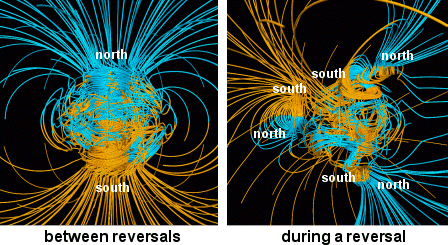
The past couple of weeks everything has been breaking. The hob broke – well, it overheated. Which in itself is crazy – why does a hob overheat? Nuts. Then the car broke down, then the TV. Then almost me. It's been expensive. This sort of thing is how I expect the geomagnetic reversal to go – things just gradually breaking down, limiting what you can do each day, stranding you in your home and forcing you to make your own fun for a while. Well, 7000 years. That's how long a reversal can be, apparently. The car was the worst - it broke just at the start of the summer holidays, right when we want to be carting the kids about to see their pals, or go swimming or whatever. But in a way, it was good. They had to stay at home, invent their own strange games and stare at the ceiling a bit. I swear down my childhood was 75% spent staring at the ceiling or lying in the grass just looking at stuff. I think that's still where I feel most comfortable. It's certainly where I go when things start to feel a bit heavy.
Why do we do that? Why do we say things feel heavy or light? It's not like there's any mass to an emotion, is there? Maybe there is. I've never actually weighed myself when I'm stressed. I should do that. Perhaps if I force myself to be happy all the time I'll lose this stubborn lockdown KG that's hanging around my bellybutton. Easier than a diet, maybe?
0 notes
Text
Muddling through
Does anyone really ever know what they’re doing? I suspect not. I certainly don’t. A few years ago a friend and I gave a talk to a bunch of bewildered students about the importance of never knowing exactly what you’re doing. It doesn’t work for all professions (I wouldn’t want to be under the knife of a surgeon without them knowing EXACTLY what they were doing), but for designers, artists, ‘creative peepul’, it’s important. I can’t remember precisely what we told them, but I stand by our key points:
1. If you know what you’re doing, the result is predictable
2. If you know what you’re doing, you’re closed to less-obvious solutions
3. If you know what you’re doing, you’re less likely to be listening
And strictly selfish:
4. If you know what you’re doing, it’s less fun
5. If you know what you’re doing, you’re not learning
I say selfish, but actually you’re no use to anyone if you’re miserable, and a sure-fire way to be miserable is to have no fun and to stop learning. So those last two points are in everyone’s interests.
Anyway this all reared its head recently because I started a new job. New jobs are full of uncertainty, self-doubt and that feeling of being a fraud. But you just kind of suck-it-up, otherwise what are you gonna do? ‘Hey sorry, I know you used your years of professional experience to make a judgement about whether to hire me or not, but I think you were wrong and I don’t know what I’m doing’. No, thought not. It doesn’t make the feeling go away though.
Luckily for me, I’ve never had a clue what I’m doing, so the feeling is less pronounced these days, or maybe I just notice it less.
Another benefit of not really knowing what you’re doing is that you end up trying a lot of new, interesting things because you’re constantly exploring. That’s what lead me into design in the first place: every new job demands you become somewhat of an expert in a new field, so you’re always learning great new stuff. Recently I’ve been looking at new (to me) ways of visualising, communicating and designing for experiences.
A video posted by Rob Peart (@legendaryhappiness) on Apr 4, 2016 at 6:58am PDT
This is an experiment using processing. It’s kind-of basic, but the blobby shape responds to the sound (volume) of your voice as you speak. It amazed me how quick it is to get this kind of thing up and running. I have no use for it right now, but I know I will…

Here’s another. Again it’s basic. But you can talk to your computer through the browser. It only works with Chrome, and is pretty buggy. But it uses Chrome’s built-in speech recognition to turn your voice into a string. It then passes this string to a chatbot api, who then returns another string, and another javascript library turns that into sound. You can try it here. Be warned, it doesn’t work too well. Fun experiment though. Again, totally amazed that this can be built by a pleb like me in about an hour. The image is from here. If you look closely, you can see the strings it’s transmitting and receiving in the top-left of the window.
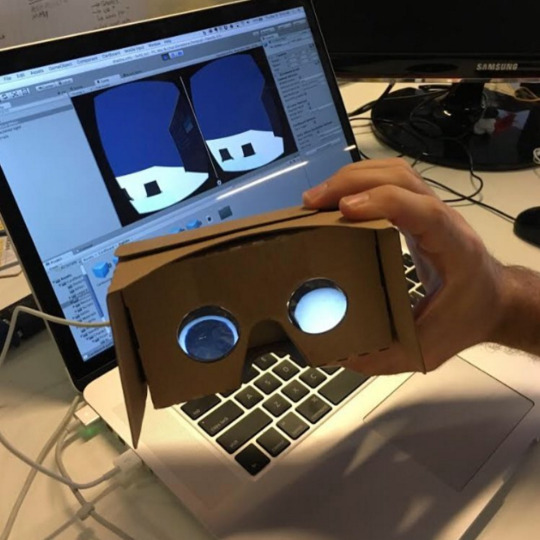
Lastly, for now at least, this. SketchUp is free. Unity is free. Google cardboard SDK is free. You can create an environment and have it running in Google Cardboard in about an hour. You don’t even need SketchUp, but I knew how to use that. Yes it looks a bit shit, yes you’re still connected with a wire to the computer. But this is a brand new experience. A new way of seeing. And you can be there in an hour. All because you don’t know what you’re doing.
0 notes
Text
Thrills n spills
Recently I had to do a show and tell thing at work where we talk about all the stuff we're doing outside the office. You know the kind of thing. I've been able to find the time to explore different technologies that I find interesting, so I spoke about that. It's funny, when I was a kid my siblings used to call me Boring Rob because I'd read the MS-DOS manual at night, trying to learn how to program our family computer. I'm reliving those days again. I'm way out of my depth of course, but amazed at how much more simple it is to build stuff now than it was even a couple of years ago. It's thrilling (but then I am Boring Rob, so...)
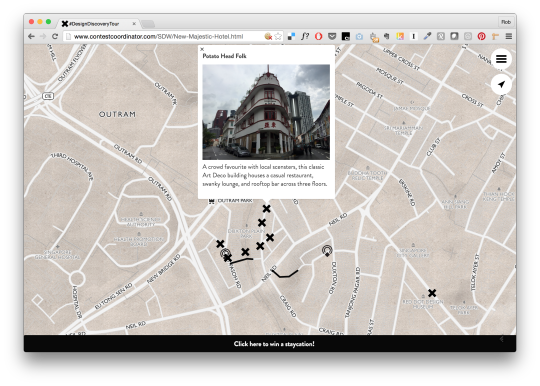
Here’s a thing Greg and I teamed up to create for Singapore Design Week. It’s a map of points-of-interest that surround a hotel in Bukit Pasoh. Originally we wanted to surface the historical stories in the area, as they’re buried beneath multiple levels of gentrification—turns out they’re too buried and no-one can remember what the area was like. So we went with a different approach (admittedly contributing to the issue we set out to address). You go into the hotel lobby where there is an iBeacon that pushes out a Bluetooth signal containing the URL to our map. You pick this up through the Chrome browser on your smartphone, and access the map. There are a few other beacons on the tour that give you access to things like secret food menus.
The map is built on a platform called MapBox, with some additional customisation and fiddling about with a javascript library called Leaflet.js. That’s all chucked into a webpage with a menu and location button, and you can pick it all up on your smartphone.
It’s pretty basic, and the usefulness of this particular execution is arguable. But it’s a good demo of how two digital technologies can link to physical spaces. We got to explore a ton of technology we were interested in and develop a use for it. We tested that with real people, got some use-data and solid feedback. Now we know the limitations of it and what can be improved. A great exercise.
5 notes
·
View notes
Text
Picks XXII
1
There’s a horse somewhere on dartmoor with a fluorescent strip painted down its flank, wondering where it went wrong in life. We’re adapting the world to suit ourselves. ‘Hey horse! I want to drive my car reeeeeeally fast down this road, so if you don’t wanna die you better let me paint this yellow strip on you’. It’s not even a good strip. It looks like a mouldy streak of piss.
2
The parameters within which things are judged as being radical are narrowing. It feels like reality is getting smaller and smaller by the day. Apparently, repair is now a radical act. And not wanting to bomb the fuck out of everything is extremism.
3
We’re asked to fight against, but we’re not asked to fight for anything. And there’s a difference. One is a negatively framed struggle against dark forces that pose an existential threat. Call it ‘defeating evil’. The other is affirmative action based around a set of beliefs that can form a vision of the future worth the fight. So what? Well, one tries to give you a genuine reason why. The other doesn’t. It’s hard to emotionally invest in hypocritical posturing devoid of any real ideological substance. And its easy to be lead astray. Also,when did ideology become a dirty word?
4
Some people are forward thinkers. I don’t mean futurists or clairvoyants, I mean people that think about the consequences of their own actions, and also the consequences of the seemingly inevitable and plan accordingly. Drones will happen. So let’s at least try and do it right. Cities will become more populous, people living much closer together physically and mentally. Let’s acknowledge that and plan them properly so that we don’t bulldoze identity. And the rest.
5
There are some things we just don’t understand, and don’t even try to. But those stories must still be told.
0 notes
Text
Some things converging
It is not necessary for a character in a story to be aware of that story. This is not something we understand instinctively or intuitively. The films we watch are focussed on a hero’s journey, and we automatically interpret the other characters as being part of that hero’s story … I started to wonder if there was such a thing as a story that no one knows they are in—least of all the main characters. Could a complete narrative develop by itself with no one guiding or steering it?
The KLF: Chaos, Magic and the Band Who Burned a Million Pounds.
John Higgs.
Fredkin believes that the universe is very literally a computer and that it is being used by someone, or something, to solve a problem. It sounds like a good-news/bad-news joke: the good news is that our lives have purpose; the bad news is that their purpose is to help some remote hacker estimate pi to nine jillion decimal places
The Singularity is Near, Ray Kurzweil
More and more devices are location-aware, or talk to devices that are location-aware. This lets you recreate people's movements decades after the fact, something we've never been able to do before.
If you have a predictive search engine, it stores all kinds of things that people paste into their text fields by accident, including passwords. And you probably don’t know this. The whole point of having a data lake is so you can just chuck things in there and go fishing for patterns later
Haunted by Data, Maciej Cegłowski
MIT researchers aim to take the human element out of big-data analysis, with a new system that not only searches for patterns but designs the feature set, too.
System that replaces human intuition with algorithms outperforms human teams
All I was wondering about was that Spotify knows how to push my musical buttons better than my wife and closest friends.
1 note
·
View note
Text
Developing urban Smarts
It’s difficult to avoid talk of smart cities and smart nations here in Singapore. The transformation of Singapore into a smart nation has been going on for quite some time. I’m told that it was one of the first countries to have an online presence for all of its government departments, and being an island state, with limited land and resources, the world watches as Singapore starts to come up against challenges sooner than anyone else might, but that everyone will have to face eventually. People want to see how the country deals with these challenges so that they might be able to learn from their successes and failures. Things like water scarcity, an ageing population, the need for mobility, increased digital literacy and the benefits and threats that all those things entail.
The vision for Singapore as a smart nation appears to be quite literal, and what’s described at the link is really about technology and connectedness, and how the data generated by this might lead to innovation. There’s no mention of a why. Its easy to get caught up in ideas of entrepreneurship, connectedness, big-data and sexy-smart-cities with fantastic public services, and lose sight of the ‘why’. Why do we want to ‘optimise’, who are we optimising for? How are we optimising? Here in Singapore the smart nations initiative will be powered by the IDA—the info-comm development agency. It will be powered by data. Each Singaporean citizen will be a node on a network that contributes data to be parsed in the pursuit of progress towards a smart nation. Even if we all agree that it’s a ‘good thing’ to be a smart nation, it’s important to know why we’re headed in this direction.
Shell have been working on this kind of stuff for years, and have a website dedicated to future smart cities. They class Singapore as an ‘Urban Powerhouse’—a city that is both densely populated and wealthy—apparently quite a rarity, as there are only 8 of these globally. They put forth a more reasonable, less-sexy argument for having a Smart city:
by 2050 it is estimated that around three-quarters of the world’s population will live in cities. This rapid growth will continue to put increasing strain on our interconnected food, energy and water systems, which were never designed to handle urbanisation on this scale.
For the past 100 years or so, most urban development has taken place organically, in small steps, often with little regard for long-term sustainability. But this approach is clearly no longer fit for purpose. Instead, we need to plan our future cities much more rigorously, to ensure that they are sustainable, liveable and prosperous for decades – even centuries – to come.
Singapore has a history of meticulously planning its urbanisation. The masterplan for the next 15–20 years is visible for all to see in detail online. I can see from the plan that the state land opposite my in-laws apartment will be turned into residences. The anti-trespassing sign that I walk past each day helpfully tells me it has been reserved for development.
At the same time, the nation has benefited massively from land reclamation, increasing in area by a whopping 22% since 1965. Singapore is by far the worlds largest importer of sand, having used up all its own supplies years ago. This expansion is set to slow as regional neighbours impose export bans for both environmental and political reasons—it seems ASEAN countries want close ties with their neighbours, but perhaps not literally.
The next step for Singapore appears to be a move underground. At first this sounds crazy, but for the time being it’s limited to infrastructure. The planners are looking for ways to move bulky installations underground to clear space for more development above ground. But given the cost of subterranean development—approximately 10-times more costly than regular development—it’s yet to be seen if this will offer good value for money.
I began thinking about potential future scenarios that might arise from these concurrent moves towards a Smart, underground nation.
1—Virtual civic spaces
The independent vectors of increasing population density and increasing digital connectedness push planners to redevelop all public and communal physical spaces, and give them over to units dedicated to directly-measurable productivity. Retail, office and even residential units can all now be measured in terms of GDP: residential being measured on the data harvested from tracking the behaviour of inhabitants.
However, a Smart Nation understands the value of communal meeting spaces, and knows that spontaneous knowledge sharing in open public forums can facilitate creativity and innovation. So the state looks for ways to build public forums in online space, as a substitute for the lack of genuine public forum.
Some questions relating to this for exploration: What do these look like? How do people interact within these ‘spaces’? How does etiquette develop, serendipity, overheard conversation? Nosiness, privacy, unspoke rules? Critical mass? Speakers corners? The unpredicatibilty of weather / environment as starting points for conversation? Body language? Tone?
How to signify the end of a conversation? Play, stupidity, demonstration, visibility, ‘happenings’, events? Is there even a need for events to take place in the same public spaces, or are there different public spaces for different needs?
2—Let it all hang out
The approach to adopting citizens as data nodes has created something of a level-playing field with regards to privacy. There are no secrets. Anyone can know anything about anyone else, if they want to. In this situation, we have a city in which the populous has evolved an ‘all-out’ approach to privacy. Something curious occurs: instead of this being something that represses the inhabitants of the city, it becomes liberating. No-one self censors because it’s pointless. The city is now a brash, burley, give-a-fuck society.
The outcomes of this are slightly harder to imagine. Two things that are worth exploring further in this context are how media operates and how law-enforcement works. These are both linked by the idea of reporting: if there is no hierarchy and pervasive data about absolutely everything, then what is worth reporting?
Scenario inspired by the below:
"The new normal, where everyone knows your business, could be a good example of plus ça change, plus c’est la même chose. And it’s worth pointing out that Raymonde Guilhou wasn’t stopped from doing as she pleased by the beady eyes of her fellow villagers. Maybe we’ll become inured to the gaze of others, and end up letting it all hang out, with no regrets."
Privacy is starting to seem like a very 20th-century anomaly, David Shariatmadari
3—A diffuse state
A smart nation focussed on connectivity and data does not only connect with itself, but also looks outwards for even bigger data. (Actually this is happening now with Singapore and the UK). It is not only connected to itself, but also to the outside world. Singapore is a secular nation, and as such is united by a strong, optimistic and largely positive national ideology. The failure of many other nations to offer their citizens a believable future, combined with the destructive effects of international terrorism and the narratives and ideologies behind such behaviour, citizens from other countries are keen to contribute towards the positive forward momentum of Singapore. It is also a large target for terrorism in the region.
Because of its small size, and the fear that increased immigration may lead to increased probability of domestic terrorism, Singapore begins offering associative citizenship: the opportunity to become a Singaporean citizen, fully signed-up ideologically, without the need to be geographically located in the country. Singapore becomes a diffuse and borderless nation state, pulling data in from international nodes in its network.
Related: The town that took itself offshore to expose tax avoiders,
The bizarre scheme to transform a remote island into the new Dubai,
"Shared Values" & their role in Singapore’s evolving ideological framework
1 note
·
View note
Text
Strategy and tactics
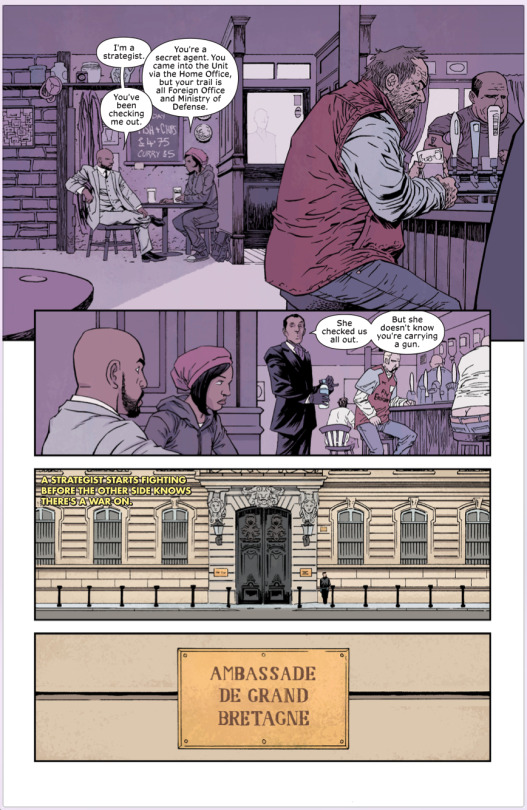
A strategist starts fighting before the other side knows there’s a war on
The Injection Warren Ellis
It’s from a comic. So what? It illuminated me. For a long while I used to get terribly tripped up by strategy in design. What is it? Why does it matter? What do all these graphs mean? Aren’t they a bit arbitrary? Isn’t it useless unless it affects a change, or outcome, or action? I think this frame sums it up brilliantly. It’s about identifying and planning for things that haven’t happened yet, and actively doing something about them.
Then there are the tactics. If the strategy is the context and the goal, then the tactics are the small steps that help get you there, the actions and reactions.
Design by it’s very nature is concerned with the future—the outcome of design is often the creation of something that didn’t exist previously. I’m not talking only about objects here, but also situations, experiences, conversations. So design and strategy have to go hand in hand. I don’t really like to separate out these as two distinct parts as they’re so closely related, almost fractal-like. Of course you have to understand your context and give yourself a broad goal to aim for at first, even if it’s mis-aligned to begin with. But properly deployed and targeted design as research can help to sharpen-up the strategy and make your goals clearer. It can be a mechanism to encourage listening and evaluating as well as creating the usable outcome. That’s tactical.
3 notes
·
View notes
Text
A post about design
It’s been a weird few months. Being away from familiarity and starting again from scratch has had me on the back-foot. And so I have spent a lot of time thinking about what I do.
Around this time last year, I started writing this post. It’s a kind-of toolkit of principles that I go back to occasionally that keeps me on the straight-and-narrow. It’s been useful, especially recently when I feel I have been loosing my way a little. But it relates to process, the ‘how’ rather than the ‘why’. Suddenly it’s not enough.
So this is the niggling question that I have only just acknowledged: why do I design? What’s the value I see in it? We all inevitably choose something to to put our effort into, so why this, for me? And as soon as you recognise the question, you start trying out answers for size—sometimes in your own head, sometimes by trying them out on other people. I think I found one that fits me reasonably well. And this is me testing it out.
I went back through my work—all of it, looking for clues. What did I enjoy, and why did I enjoy it?
This one, for Unilever. I loved working on that. It was the sense of collaboration, of optimism. But mainly that we were helping to make tangible items that embodied an idea that people could talk about. The project didn’t end with our output, it had just started. I don’t explain it brilliantly there, but I hope you get the idea.
This one, Zineswap. It’s not a project, but a service. And it’s ongoing. Albeit sporadically. We do it so we can give something back, we can connect peoples ideas with one another, in a way they might not otherwise have been able to.
There’s another one that would slot in right here but I can’t ever show it to anyone. An experience in which every detail was designed to encourage conversation and sharing with a view to building long-lasting relationships.
Much more recently, this one. It’s a simple web app, but it gives me huge satisfaction that people are using it, and a lot. It suggests that the original service is too hard or annoying to use for this single purpose. We should talk about that.
Even more recently, and currently top-of-the-charts, this one with Future Everything. Not really a project, I was more of a participant. But this is what put me on to the answer I think currently fits well for me:
I believe designers are in a unique position to provoke powerful conversations. Through tangible output we’re able to ask ‘what if…’ in a way that ignites the imagination and sparks debate. I know that sounds cheesy, but it’s so so powerful. And I feel like I don’t do it enough. These are conversations that can grow into debate about the present and the future. Conversations that can develop into meaningful relationships between people, organisations and the environment. Conversations that identify areas that need to change, that can become better, that can illuminate an alternative to the seemingly inevitable. The examples I gave about of my own work are barely scratching the surface of this thought. But suddenly I have something to aim for. And I’m going after it.
So why do I think this? As designers we’re inherently curious and analytical. One of the biggest tasks in the design process is being able to ask the right questions. But more than that. We’re creative. We make things. Not only can we propose answers to those questions, we can do it in a way that no-one else can: through tangible objects, experiences, products, services; real or imagined. We can demonstrate our proposed answers, instead of explaining them. And even more than this, by seeing people interact with our proposals, we can make them better, over and over and over again. This is why. And the outcome of this? A designer’s job never ever ends. You’re always starting. Always learning. Always questioning.
I think that’s a pretty damn good way to spend my time.
0 notes
Text
Signals of Tomorrow
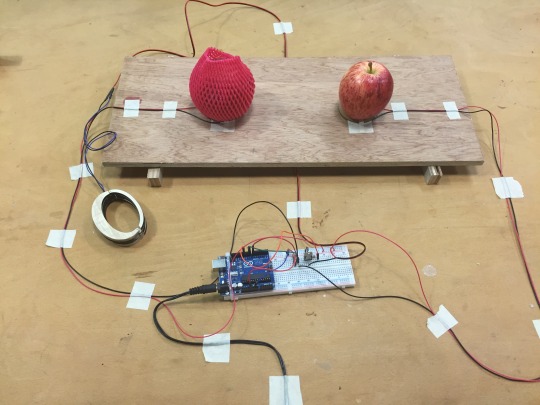
A few weeks ago Future Everything came to Singapore. I was lucky enough to take part in the Signals of Tomorrow innovation lab on-and-off for the week. I’ve been itching to write this up for a while, but wanted to wait until the whole thing had wrapped up and let it all sink in. It all ended a few weekends ago, culminating in an exhibition of the work generated during the lab at the ArtScience Museum. It’s been a transformative experience for me personally, and I know a few others also felt the same. I was sad that it ended. Massive thanks to the organisers for running such an intense and inspiring session.
This is a LOOOOOOOONG post, more for me than for you, if you know what I mean. But if you’re interested, well, then, good.
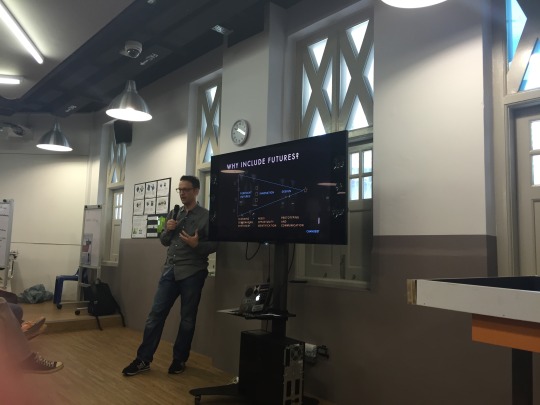
The lab began last Saturday at 9am. We kicked of with an intro-session lead by Scott Smith which set the tone for the workshop. He explained to us what signals of the future are, and took us through some of the processes he uses in his own work. Utterly fascinating. A signal from the future is a little glimpse of a future world that is seen in the present—a little object or behaviour or situation that you can potentially extrapolate a future scenario from. To give an example, someone brought in a planning notice from the UK: a completely user-hostile piece of information design, probably purposefully counterintuitive so as to let dodgy developments slip through the net. From that you can extrapolate a future in which public space is at a premium or non-existent, people are uninformed of the way their urban spaces are being shaped and developed, and a world in which human-interaction with the built environment is fragmented with a lack of narrative, navigation and legibility. That’s a basic example, and there are many other factors that go into building these scenarios, but thats the gist of it.
Our task was to identify some of these future-artefacts in Singapore in the specific context of the Smart Nation, and over the next day or so build up a picture of a theoretical future-scenario. We’d then develop a prototype either in response to that, or one that helped to demonstrate what life might be like in that scenario. By this point I was buzzing. Super excited.
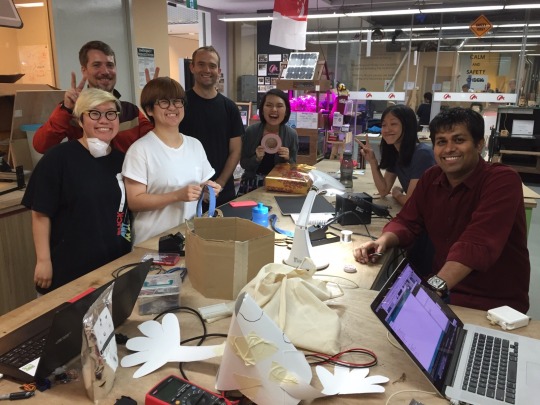
We formed 6 loose teams and kind-of drifted together with our design lead for the week. Our team was lead by Andreas Schlegel, with Spangandlei, Mel, CK, Min (no link, sorry Min!), and me. Over a lot of discussion and opinion— all dimplomatically navigated by Andreas — we identified a couple of themes that were really interesting to us that we might want to start to tackle. The first was the idea that a Smart Nation is by its nature Always-On, so how does a citizen opt-out. Can you make a decision to be a dumb-citizen in a Smart Nation? Or are you locked in? We called this ‘primitivizing oneself’. The second theme we gravitated towards was that in a Smart Nation technology does a lot of the empathetic, caring stuff for you: for example you can get a sensor that tells you when your granny falls over so you can rush around there and help her out. But what this does is alleviate you of the need to go round there so often because you’re relying on the sensor, absolving you of responsibility. So our other theme was about technology that doesn’t care for you, but that empowers you to care.
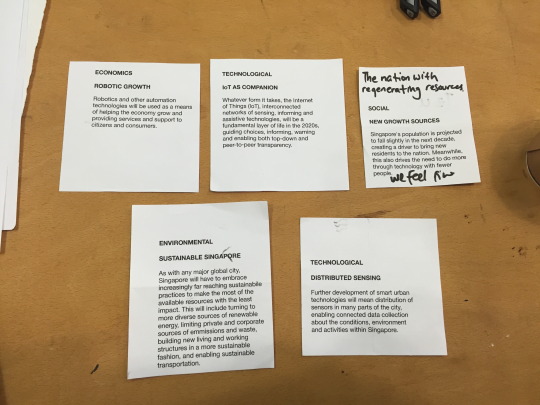
At some point in this process Nat and Scott introduced what they called Meta-Drivers to help us frame up some of our themes. Meta-drivers, they explained, are forces that will influence the development of the future in a very broad way. And like the future-artefacts, they’re small clues that exist now that allow you to speculate, so they’re not necessarily guaranteed. They explained the STEEP framework to us which allows you to identify and categorise the drivers: Social, Technological, Environmental, Economic and Political. They’re picking this stuff up in all sorts of places: newspapers, government reports, podcasts, all sorts. Really fascinating stuff. They had pulled together about 30 drivers that related specifically to Singapore: things like the aging population and low birthrate, the lack of natural resources and global water-scarcity etc. We had to look at our themes, and see if any of these drivers could help us to bulk-out our future scenario. They kind-of act like a frame to view your themes through. At the time it was a bit confusing, but the more I’m writing this up the more I’m understanding what we were doing.

That took us until lunch time, when we had to explain our general themes. We were a bit rocky to begin with, as I think we were all a bit overwhelmed and not sure exactly what we were supposed to be doing, but we were having fun so it didn’t matter. Andreas took the hit and explained our vague and noodling thoughts to the wider group, and we went and had lunch.
When we reconvened, the organisers had brought in some ‘community champions’ from all kinds of different industries in Singapore. A bit like the meta-drivers, these people were to be assigned to the groups to help shape the future scenarios. We worked with a chap called Yugene, an environmental consultant. This process was completely invaluable and this is where we were really able define the particular issue that we wanted to tackle. This is also where we would have really fleshed out our scenario, but we were still a bit confused by the idea of the scenario so sort-of avoided it. In hindsight I understand totally, but at the time it was a bit wooly.
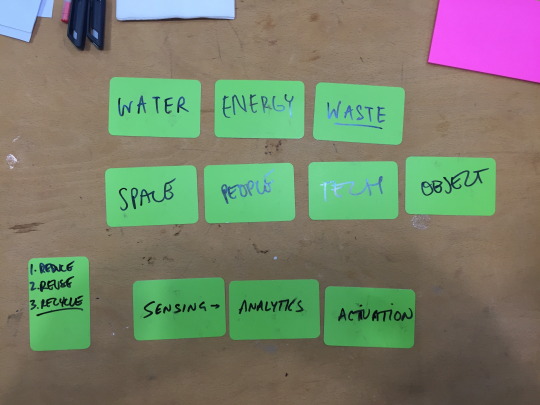
Very quickly Yugene helped us to concentrate on the ‘empowering to care’ theme we’d been interested in. Yugene was explaining that his job was to advise companies on the best way to reduce their consumption of energy and water, and reduce their waste output. We wrongly assumed that they key to doing this was educating the business leaders on the environmental consequences their actions had. Turns out most of them are fully aware of the effects of their business, but, well, business. This then gave us the idea to develop something that would enable people to feel the consequences of their actions, for real. Or as Drew Hemmet, organiser of the event said: ‘it allows you to experience the pain you’re causing to the environment’. We also wanted to give some positive feedback, so if you make a decision that has a positive effect, or maybe a ‘less-negative’ effect then you’re rewarded somehow.
It’s worth pointing out here that our aim was not to be practical with our idea, but to create something that could bring an issue into focus. An anchor-point for discussion. This was never meant to be able to become a viable business. Fantasy is fine.
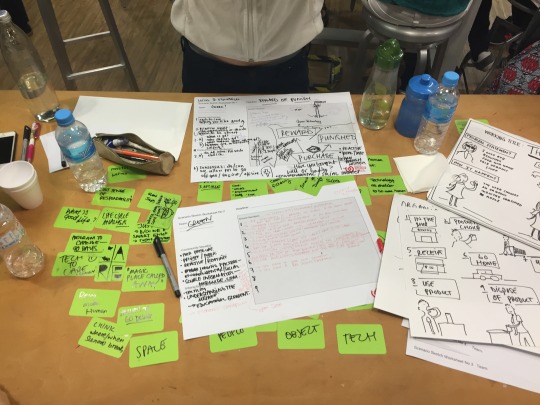
CK helped nail down our target to the consumer themselves: consumers have purchasing power and drive demand, so if we can change the behaviour of the consumer then theoretically there would be a trickle-up effect to the product manufacturer. With Mel’s amazing drawing-skills we quickly sketched out a summary of the idea, and also a super-basic hypothetical scenario of going to the supermarket to buy an apple. This consumer-cycle plotted out each point in the journey, from your method of transport to the store, all the way to consuming and disposing of your product. We then assessed the cycle for two things: where was the consumer making decisions that could determine feedback, and at which points could you deliver this feedback. For example, the checkout process doesn't appear to have either a positive or negative impact on the environment in relation to the rest of the cycle, however, it’s a great opportunity to deliver feedback as all your items are on display and being recorded, and there’s someone there to deliver that feedback.
Serena and Lei were particularly brilliant at coming up with uniquely Singaporean ways of delivering feedback at various points, ranging from the punishment of having the air-conditioning in your home rationed, to the reward of giving you express priorities when queuing at the checkout. This was a fantastic exercise, and we ended the day feeling tired but optimistic.

The second day started with less of a bang—we were all so tired. Also, after feeling like we’d done a good job of narrowing down our idea on the first day, we realised we were still a long-way off having something that we could make into a tangible summary. Andreas took us downstairs to look at the exhibition he had organised at the NDC—urban explorations. There were a ton of amazing installations and artefacts that were developed to provide an alternative view or vision of the urban landscape. Essentially each piece took input from the environment, filtered it somehow, and turned it into some kind of output. Although quite abstract it gave us a lot of ideas on how to deliver feedback. Andreas had been thinking a lot about the project overnight and had mentioned the idea of a wearable the previous day. He demonstrated one particular exhibit that vibrated in different ways depending on what it was in close proximity to, using an electromagnetic sensor. It was a powerful response, and something we could imagine building in the short time we had.
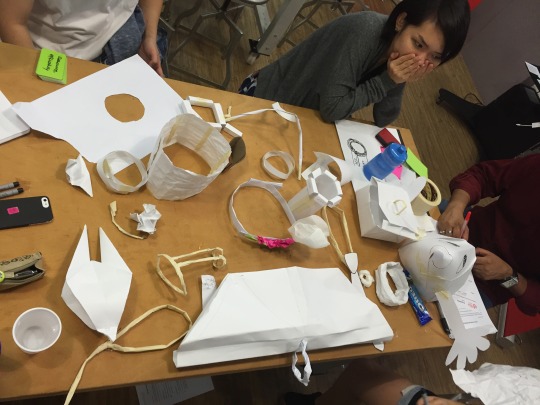
We agreed make a wearable, and so began making some quick-and-loose paper prototypes of what this might be, and how it might deliver feedback. This was a fun process. Suddenly we were thinking in terms of things instead of just abstract ideas. Thinking by doing, with our hands, instead of thinking about doing. As a side-note, I’m reading GEB at the moment, and there’s a part in the book about formal systems—systems with concrete rule. I guess you could also call this a process. There are a few modes of thinking when using systems: mechanical, intellectual and un-mode. The first two describe thinking within the system, and thinking about the system. I guess this exercise was an illustration of that. We were thinking within the formal system—prototyping things that fit within the vague-ish rules of what defines a wearable. But also we were discussing as we went along and redefining the rules of the system and what did and didn’t constitute a wearable.
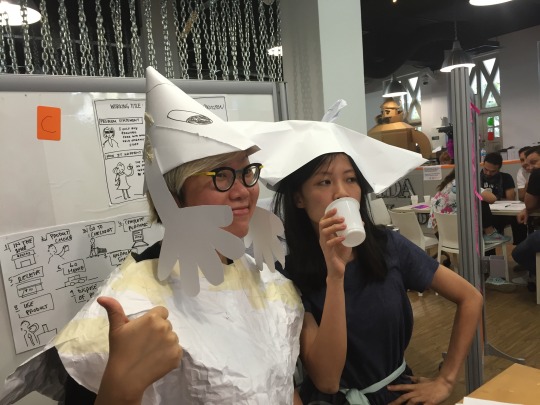
In this kind of situation you’re always pushing and prodding at the boundaries of possibility. First you’re timid, and everything you produce is very familiar and boring. It’s an essential part of the process and you just have to plough on through. It’s like the warm-up, the stretching session. Then you get a bit more daring, and before you know it you’re taking things way too far and everything is totally mental. But this is good, because hidden in each of those otuputs is something useful. You just have to boil it out. So that’s what we did. And soon enough we had an idea that we wanted to take down to the laser cutter.
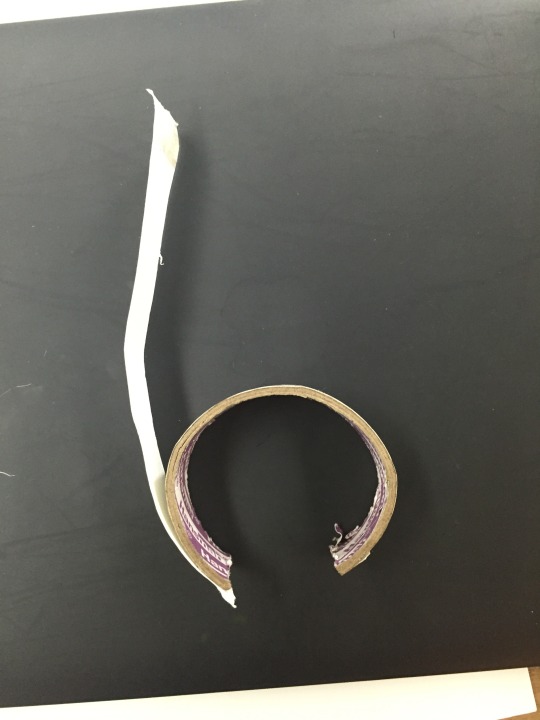
From this point onwards, the entire process we went through was a massive feedback loop. At first our designs were way too big. So we made them smaller. Then it was hard to get them on-and-off, so we added a hinge. Then we had to develop a clasp.

During this process, the idea also began to firm-up, just through the application of practical constraints. Some of the weird and wonderful punishments we had initially come up with had to be tossed by the way-side as there was no way to prototype them in the time we had. We settled for a very simple vibrating-feedback, that acted as an alarm or an encouragement depending on the choices you were making in the supermarket.
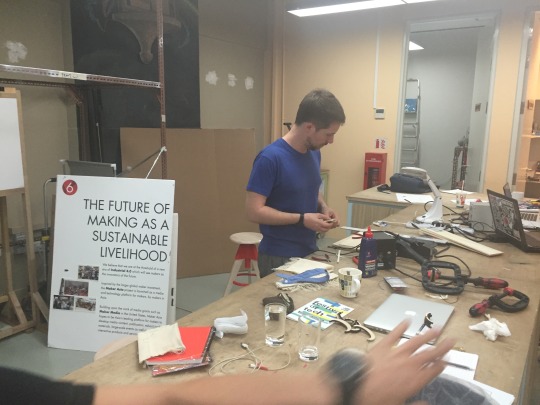
So we also had to work out the level of feedback to give in each of the scenarios—what kind of vibration felt like an alarm? Which kind of vibration felt encouraging? This went on-and-on until we had something that worked. This is also where the group dynamic changed again—we kind of all split out. Some operated the laser cutter, others focused on the electronics. Others on the design files, and others on the documentation. It naturally happened like that. When you have a group of pro-active people, you don’t have to tell people what to do, it just gets done. That was beautiful to experience.
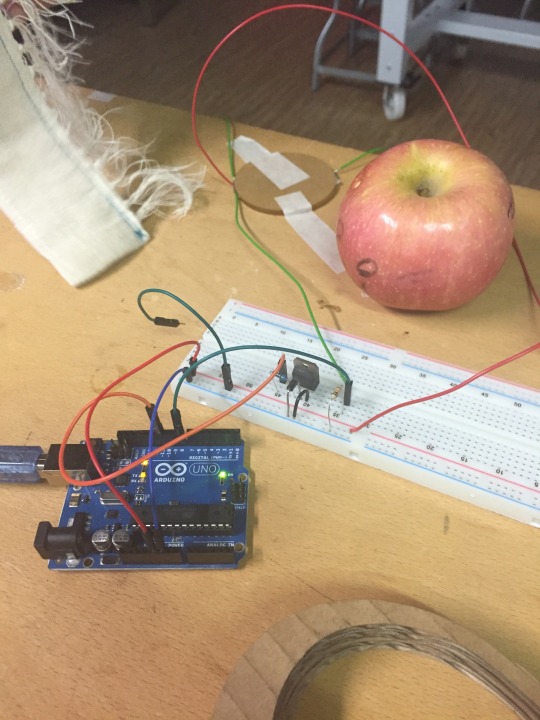
So by the end of the two days, we had a sort-of working prototype. I had to step out at this stage because of work commitments, but I popped back to the lab after work a couple of times. It seemed like everything continued at the same break-neck speed for the rest of the week.
At the start of this post I mentioned that this was a transformative experience for me. There are a number of reasons why.
Firstly, the exposure to a method of thinking about the future in a structured way that lends itself well to creating outputs. These outputs are so powerful: they provoke, they narrate, they demonstrate. They prod and poke at the future, and at their most powerful, they illuminate a journey forwards.
Secondly, I felt very powerfully the benefits of thinking by doing. Of course I’m striving to do this all the time with my work, as I’ve mentioned before. But I often work in 2D, in simulations of what the final thing will look like, instead of aiming to get to the final thing very quickly. At all points you have to trick yourself into thinking you’re working on the final thing.
Thirdly, and I think this comes through quite clearly, is working processes. Process is almost like a naughty word in the design or creative industries. ‘How can process give rise to creativity, it’s not mechanical!’ I see process as a guide, a roadmap. Of course you can go off-road at points, and explore shortcuts and scenic routes, but ultimately you have a destination, and various milestones along the way let you know you’re on the right track. And more than that, if you don’t get to the first milestone, you can’t get to the next. Zeno’s dichotomy paradox?
And lastly, group dynamics. Working in a loosely organised groups can be frustrating, but here it worked. Consensus on process worked, a loose ‘leader’ who owned the project worked, proactive people who were vocal about their skills and weaknesses worked. Brutal honesty and unemotional reception of feedback worked. But more than that, engaged, optimistic and welcoming people. In this case it was a fluke. But it’s definitely something that can be replicated.
Amazing. I feel exceptionally lucky to have experienced this. Masssssiiiiiiiiive shout-out to all involved.
2 notes
·
View notes
Text
Routines
Be regular and orderly in your life, so that you may be violent and original in your work.
Flaubert
For the first time ever in my life I've got a pretty set routine. Even the clothes I wear each day are basically the same because the weather doesn’t allow for much else. I’m not sure if it’s making my work more violent or original, but I am finding that a reliable rhythm for mundane decisions means I’m able to shift effort into the harder decisions I have to make at work. And I’m also finding that when I skip some steps of this unofficial routine, it’s much harder to get anything meaningful done.
The routine isn't just on a daily level either, but seems to be stretching to weekly events too. It’s also interesting to see that it’s much easier to compartmentalise ‘work’ and ‘personal work’ so I’ve got much more time for both, and dedicated time for family.
I never had myself down as a creature of habit, but I quite like it.
0 notes